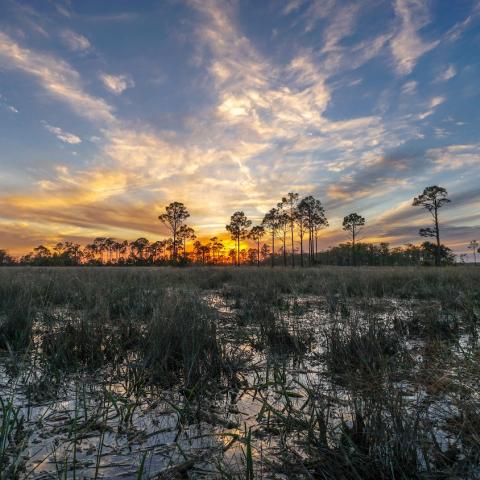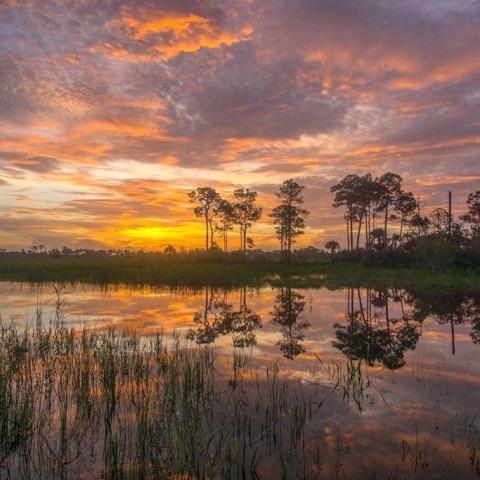
Conservationists were turned back in their bid to see more wilderness designated at Big Cypress National Preserve in Florida/NPS
National Park Service managers relied on their expertise and did not violate either the Wilderness Act nor the National Park Service Organic Act when they decided how many miles of off-road vehicle trails would be allowed in the Addition Lands of Big Cypress National Preserve in Florida, the 11th U.S. District Court of Appeals has ruled.
The 21-page ruling (attached below) gave total deference to decision-making on the matter by the Park Service, concluding that the arguments put forth by the National Parks Conservation Association, the Sierra Club, South Florida Wildlands Association, Public Employees for Environmental Responsibility, and Wilderness Watch "can be reduced to a disagreement regarding the (National Park Service's) and (U.S. Fish and Wildlife Service's) ultimate conclusions."
"It is unsurprising that reasonable minds can differ regarding the interpretation of the copious amount of data upon which the NPS and FWS relied when making their decisions," wrote U.S. District Judge William T. Moore. "However, it is clear to this Court that the record contains substantial evidence to support those conclusions. As a result, it is beyond the power of Appellants and this Court to second guess these agencies' reasoned decision-making."
At the South Florida Wildlands Association, Executive Director Matthew Schwartz was not just disappointed with the ruling, but worried about what it might open the parks up to.
"The court is greenlighting a National Park Service decision that is all but guaranteed to degrade the resources of one of the biological hotspots of North America," he told the Traveler in an email.
"On the basis of NPS’s own research, we can expect destroyed vegetation, compacted and oxidized soils, changed hydrology, disturbances or even harm to wildlife including federally listed species such as the Florida panther and eastern indigo snake, and the spread of invasive plant species such as Brazilian pepper throughout the Addition Lands," he added. "Non-motorized visitors who go to the Addition to see one of the last intact parts of the Big Cypress Swamp are also going to be impacted by exhaust fumes, loud engine noises, and deeply rutted trails. All of the off-road vehicle trails proposed for use by the NPS are currently in use for swampwalking.
"... I'm still shaking my head at how the National Park Service put the recreational interests of about 600 off-road vehicle riders – the number of permits they plan on giving out - over the protection of such a rare and ecologically valuable piece of public land."
The Addition Lands had been closed to both ORV use and ORV-assisted hunting ever since they came to the preserve in 1996 while officials worked on developing a management plan for the area. Of the thousands of species of flora and fauna found in the Addition Lands, nearly 100 plants are listed by the State of Florida as endangered or threatened, while 29 animal species have federally protected status.
The case dates to November 2010, when then-Big Cypress Superintendent Pedro Ramos released the final version of a management plan for the Addition Lands. It called for up to 130 miles of ORV trails, and as many as 650 ORV permits annually. Along the way to developing that plan, his critics alleged that the superintendent and his staff went around Park Service Director Jon Jarvis' wishes and denied wilderness eligibility for 40,000 acres in the Addition section.
The National Parks Conservation Association, the Sierra Club, the South Florida Wildlands Association, and others sued over the plan, saying it violated the Wilderness Act and wrongly placed recreation over preservation in violation of the National Park Service Organic Act of 1916. Their filing argued that widespread motorized traffic would "degrade the unique natural resources" of the Addition Lands, "create conflict with non-motorized users, and fragment one of the last major wilderness areas in the eastern United States."
But U.S. District Judge John Steele in 2014 upheld the National Park Service's decision, saying Big Cypress officials both correctly analyzed the Addition Lands for wilderness eligibility and were within the law and not motivated by politics when they decided to remove 40,000 acres from wilderness consideration.
"The Wilderness Eligibility Assessment has been made, and there is no suggestion that anything is in the works to change it," Judge Steele wrote in his 73-page opinion at the time. "Judicial action will not inappropriately interfere with further administrative action regarding the Wilderness Eligibility Assessment, since no additional action is necessary as to that determination."
The appellate court last week agreed with Judge Steele's findings, and underscored the weight that should be given to trained land managers in assessing wilderness quality lands and how they should be managed.
"...NPS policy requires a 'managerial determination' as to eligibility, suggesting that a certain level of expertise should be employed when making eligibility determinations. In short, an area’s eligibility for wilderness designation is a highly technical judgment that is likely to be more ably performed by an informed individual with a trained eye, rather than by a mere common visitor," wrote Judge Moore.
In supporting that role for NPS managers, the judge upheld the Park Service's finding that ORV trails that existed on the lands before they were transferred to Big Cypress, along with a half-mile buffer zone around the trails, created "a substantially noticeable human imprint" that is inconsistent with Wilderness Act guidelines that call for wilderness to be free of such imprints.
As to whether the Park Service wrongly placed the recreational value of the Addition Lands over conservation of those lands, Judge Moore disagreed with arguments that the management plan did so.
"The record in this case does not establish that the (General Management Plan) improperly advanced recreational use over conservation of resources in the Addition Lands. The NPS analyzed the impact of the proposed ORV use on numerous conservation issues, and adopted measures to minimize and mitigate environmental harm," he wrote. "In addition, the GMP provides for adaptive management of Addition Lands by restricting ORV capacity as necessary to avoid negative impacts on the environment.
"The record more than supports Appellees’ claim that, relying on the NPS’s expertise in the field, the limited recreational use promoted by the GMP would not cause unacceptable environmental impairments or impacts. Moreover, the Addition Act permits the NPS to allow 'traditional recreational opportunities, so long as 'that use will not cause impairment or unacceptable impacts.'"



 Support Essential Coverage of Essential Places
Support Essential Coverage of Essential Places







Add comment